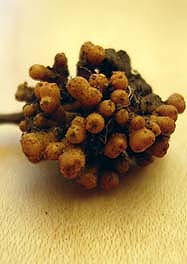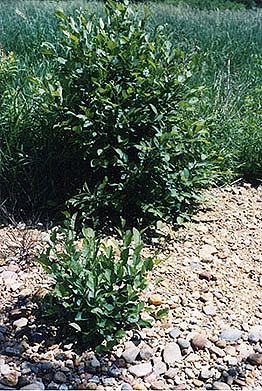
A. incana subsp. rugosa root nodule (top), and bordering a wetland in Connecticut (D. Benson)

Plant Link - Betulaceae
Alnus sp. associate with Frankia strains that are similar to those that nodulate the Casuarinaceae and Myricaceae. These "alder strains" belong to the diverse Cluster 1 frankiae. A few members of Cluster 3 have also been shown to nodulate alders but do so rarely and are poorly effective (Bosco et al., 1992; Lumini and Bosco, 1996).
Many studies that have focused on the distribution of frankiae in soil have used Alnus spp. as the trapping plant, largely because alder seeds are readily available and easily germinated. Except for a few environments such as at the foot of retreating glaciers in Alaska (Kohls, et al., 1994) alder Frankia strains are cosmopolitan and seem to persist independently of host plants.
Estimates of alder frankiae populations vary from a few per gram of soil both with and without actinorhizal plants (Markham and Chanway, 1996; Maunuksela et al., 1999; Myrold et al., 1994; Smolander, 1990; Smolander and Sarsa, 1990; Smolander and Sundman, 1987; Van Dijk, 1979; Van Dijk, 1984). Alder strains are ubiquitous outside the geographic ranges of their host plants and they can be detected long after hosts have disappeared from a site (Arveby and Huss-Danell, 1988; Huss-Danell and Frej, 1986; Maunuksela, et al., 1999; Paschke and Dawson, 1992; Paschke and Dawson, 1992; Smolander and Sundman, 1987; Wollum II et al., 1968). In New Zealand, Alnus species nodulate at every site tested though alders are not native to the island (Benecke, 1969). Ribosomal RNA gene sequences have revealed that Frankia strains in the nodules of these “exotic” plants contain Frankia strains from the phylogenetic Cluster 1 normally associated with the genera (Clawson, et al., 1997).
Conditions that affect the soil nodulation potential for alders have been proposed to include the season (Myrold and Huss-Danell, 1994), acidity (Crannell et al., 1994; Griffiths and McCormick, 1984; Smolander and Sundman, 1987; Zitzer and Dawson, 1992), fertility (Kohls and Baker, 1989; Myrold, et al., 1994; Myrold and Huss-Danell, 1994; Sanginga et al., 1989; Thomas and Berry, 1989; Yang, 1995), water availability (Dawson et al., 1986; Nickel et al., 1999; Schwintzer, 1985), the physiological status of Frankia strains (Myrold and Huss-Danell, 1994) and the type of plant cover (Huss-Danell and Frej, 1986; Markham and Chanway, 1996; Myrold and Huss-Danell, 1994; Smolander, 1990; Smolander and Sarsa, 1990; Smolander and Sundman, 1987; Smolander et al., 1988; Zimpfer et al., 1999).
Alder nodulation units (NUs) are reportedly elevated in soils beneath the phylogenetically related Betula (birch) (Paschke and Dawson, 1992; Smolander and Sarsa, 1990; Smolander and Sundman, 1987; Van Dijk et al., 1988) suggesting a natural amplification of frankiae in the rhizosphere of all members of the Betulaceae. Another study on the nodulation capacity of soils beneath birch, pine and spruce found about the same number of NUs, alternately suggesting that plant genotype may be only part of the reason for the omnipresence of alder frankiae in soils.
Relatively few studies have looked at the correlation between strain diversity and the type of soil examined. Some geographical studies have looked at the distribution of sp(+) (containing sporangia) or sp(-) (devoid of sporangia) nodules (Schwintzer, 1990). In British Columbia, sp(-) nodules of A. rubra dominate in submaritime zones with no sp(+) nodules observed. The proportion of sp(+) nodules increased moving inland, up to 53% of the total (Markham and Chanway, 1996). In some studies, acidic soils correlate with the sp(+) phenotype (Holman and Schwintzer, 1987; Kashanski and Schwintzer, 1987; Weber, 1986). Other studies have related the development of sp(+) or sp(-) nodules to the age of the stands, to plant selection or to moisture content of the soil (reviewed in (Schwintzer, 1990) and (Markham and Chanway, 1996)).
Alder frankiae are cosmopolitan and evidently quite diverse, all of which suggests that alder frankiae are soil organisms that do not require continuous symbiotic interaction. Their wide distribution is likely to be related to the ranges of their hosts. Alnus and Myrica spp., extend throughout the northern hemisphere and into South America and Africa. A member of the alder group of Frankia has recently had its genome sequenced (click here for more information)